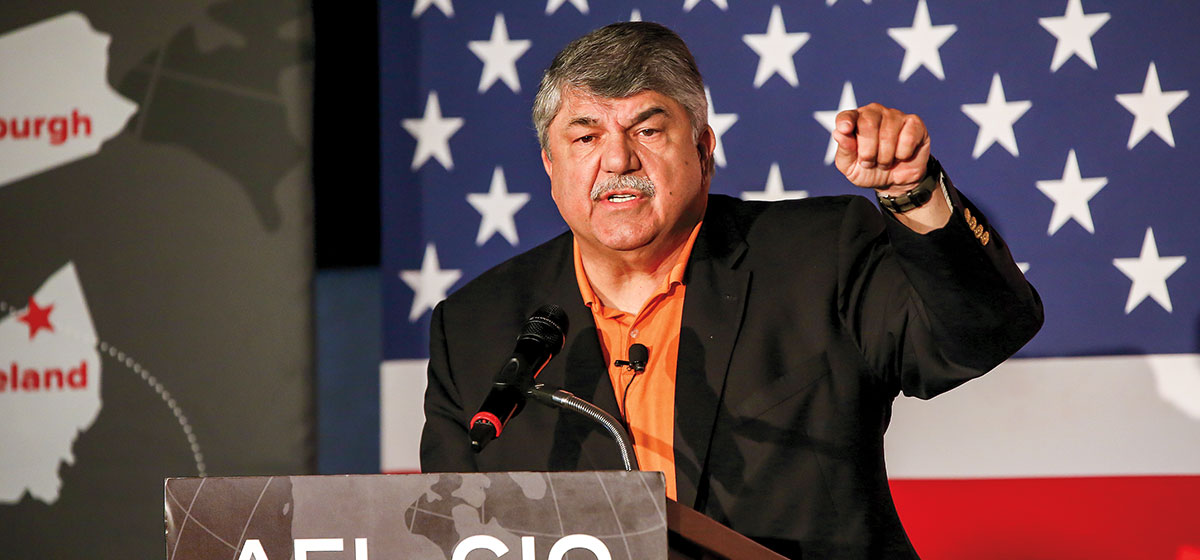Working in the Coronavirus Era

Q. How do you expect the aftermath of the coronavirus to change the working conditions for the American workforce?
A. It’s definitely going to change working conditions. It’s also going to change the way we arrange work. Social distancing is going to change the workplace. The recovery is going to be gradual. I think you’re looking at 12–18 months. If we push it too fast and get a second surge, all the stimulus money we’ve spent will have been wasted. And there won’t be the resources for a second round.
As we go back to work, there will be a transition period, and protecting the health and safety of workers is going to be essential. We have an eight-point plan. Workers have to have a say in the decision at every level. Decisions should be based on worker safety and sound science. There must be a strong, clear and enforceable workplace safety standard. Workers have to be protected against retaliation. There has to be a massive increase in personal protective equipment. There has to be a massive increase in reliable coronavirus testing. The federal government must oversee a system of reporting, recording and tracking infections. Finally, employers must coordinate with state and local governments to track the contacts of infected workers and remove those exposed workers from work with pay and without retaliation. Until these things have occurred, you won’t see a very orderly transition back to work.
OSHA (Occupational Safety and Health Administration) is supposed to protect worker health and safety. OSHA had an infectious disease standard. When Trump came in, he scrapped it. That standard would have required every employer to have a plan, to have educated and trained their employees on that plan and have the necessary personal protective equipment. Had that been in place, probably a lot more businesses could have stayed open and a lot fewer workers would have gotten infected and died. OSHA now has the fewest number of inspectors in its history. They’re a cadaver—they put them on a starvation diet to get rid of them. The irony of all ironies is the President has a coronavirus task force, and the agency that’s in charge of protecting the health and safety of American workers—OSHA—isn’t on the task force. It makes you think that workers are an afterthought or a non-thought.
Q. Do you expect a resurgence in the U.S. labor movement because of this?
A. Absolutely. Before the coronavirus hit, MIT did a study and 60 million workers said they would join a union tomorrow, given the chance. We had the highest rating we’ve had in 50 or 60 years, and what the pandemic has done is expose the structural inadequacies in our economy and the lack of power that workers have. When workers at Amazon tried to get health and safety concerns fixed, they were tossed aside. When they went out on strike, management fired some of the leaders. It also shows the lack of fairness in the economy that black people and people of color have gotten hit so much harder by this disease because they lack health care because of the type of jobs they do.
When we talk about inequality in this country, we often talk about inequality of wages. But there’s also inequality of opportunity and inequality of power. Those last two have been exposed by this pandemic and workers understand that the only way they’re ever going to get these three inequalities fixed is to join together. First you have to fix the inequality of power, then you have to fix the other two. We’re getting massive numbers of requests on our websites. They’re hungry for unions right now.
Q. What’s the most memorable circumstance or story you’ve heard regarding a worker or workers through this virus saga?
A. There was a young lady—19 or 20—in New York, and she worked in a grocery store. She was going to go back to work, and her grandmother came to her and pleaded with her not to go back, that it was too dangerous. And she said to her grandmother, “But Grandma, who will help seniors and people like you stay fed and stay healthy if I don’t go to work?” She went back to work, contracted the virus and ultimately died. That was a person who was so altruistic and ended up sacrificing her life trying to help others.
Before the pandemic, the people that we call essential workers were just as essential then, but they were invisible. Nobody saw them because they were doing their job and the economy was humming. Only when they were making the difference between the economy stopping and not stopping did people start to look at them, and now they’ll never be invisible again.
Q. If U.S.-China relations continue to erode, as expected, what will it mean for labor and the country if U.S. companies bring back manufacturing from China? What will need to happen to accommodate that?
A. First, to bring manufacturing back to the United States, we should be working to close the loopholes that allow companies to gain tax benefits and actually be rewarded when they outsource. We’ll have to continue to negotiate international trade policies so that communities and workers and the environment are on equal footing with the corporations around the world. So there’s a confluence of policy changes that can really facilitate that and make it not only good for the country but good for every one of those companies. That’s tax policy, trade policy and regulation—those things go hand in hand.
We should be bringing work back from China and lots of it. But I’m not convinced until I start to see it, because the profit motive is so high for corporations and their loyalty to this country is so low that they will continue to send jobs anywhere they can make an extra penny, even if it hurts the U.S. economy and people. Now there are certainly critical items that we need to make domestically that we don’t now. We only produce 48 percent of the items necessary for national defense. Defense electronics should come back. Pharmaceuticals—we keep getting bad drugs from China.
China has tried to monopolize rare earth magnets, used in the guidance systems of missiles, planes and things of that sort. We used to have two plants in the Unites States that made rare earth material magnets. They were both closed down. Those magnets are necessary for our national defense. China is going around the world gobbling up every place where they have rare earth so that they can monopolize supply and hold everybody, including the United States, hostage to them. To me that makes no sense whatsoever.
Q. Do we in the U.S. have the workforce necessary to accommodate such a massive move back of manufacturing? What would need to happen? Retraining?
A. We do have the workforce—no question in my mind. And let me tell you one of the best kept secrets in the world. Other than the U.S. military, the U.S. labor movement trains more people than any other institution. Our apprenticeships are the best in the world. Look at Detroit and what GM did with the ventilator project. They sourced 700 parts. They trained 1,000 workers. They build a production process from scratch and got it up and running in under a month. We have the talent. We just need the opportunity. Give us the market and we’ll fulfill it.
Q. What could something like that mean for Pittsburgh? We’ve been struggling with population losses for three decades. Our job growth is generally tepid at best. We’re always looking for something to give Pittsburgh a shot in the arm. Could this be it?
A. It absolutely could be. Pittsburgh is my favorite city in the whole world. It’s in a great position to grow from any resurgence in manufacturing. Because as manufacturing has grown more hi-tech, so has Pittsburgh. R&D generally follows manufacturing. Pittsburgh is positioned with skilled laborers, the best schools and minds in the world. Carnegie Mellon and its robotics institute are the future of manufacturing. They can do the R&D.
One of the things I’m proudest about is the relationship we built between Carnegie Mellon University and the AFL-CIO. We’re working with them on the future of manufacturing because they understand the value of worker voice in implementing technology. We look at technology—robotics, artificial intelligence, all of those things—as neither good nor evil. If they are employed so that everyone shares in the benefit in productivity of the technology, they’re good. If they are employed so that all the benefits go to a few people at the top and jobs and communities are shut down, they’re bad. What we talk with CMU about is putting the answer before the question—how will the technology affect society—before the invention is made. So that people are the first thought rather than the afterthought.
Q. How could labor play a role in changing Pittsburgh’s trajectory? Pittsburgh has the history of working and producing. How could the AFL-CIO help make things happen here if this whole migration of jobs back from China comes to pass?
A. I think the most important part is the focus on people and communities. Are we creating jobs that are accessible for underserved communities? Are we creating family-supporting jobs?
You’re not going to attract people to the Pittsburgh area to get minimum wage jobs. You have to build off the strength that we have—the technology centers, the skilled workforce and the marvelous schooling system—to start creating jobs that create a rising standard of living. Pittsburgh is well-positioned for those necessary items for growth and prosperity in the future.





